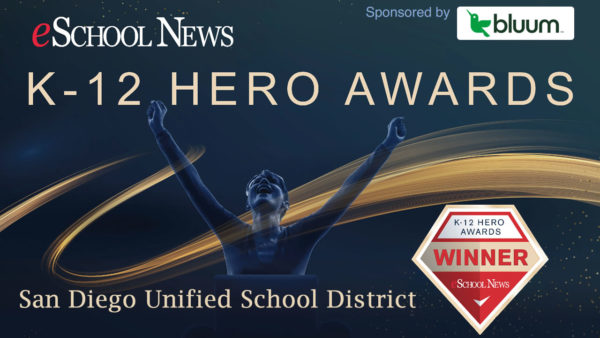Heroes at Work is a three-part series featuring excerpts from conversations with the grand prize winners of the 2021 eSchool Media K-12 Hero Awards program, sponsored by Trox. See below for the full interview.
Here, eSchool News highlights the San Diego Unified School District–one of three K-12 Hero Awards winners. Keep reading this interview with Julie Garcia, the district’s Director of Instructional Technology, to discover how the district prioritized meaningful teacher PD and student engagement.
eSN: From the very beginning of the pandemic, it seems you have had a strong focus on teacher professional development.
JG: I had this crazy idea. I thought, “Hey, teachers are at home. They never have time to learn technology on their own. Let’s just offer some fun Zoom lessons.” And so we started offering online classes for teachers as tools for engagement. We did formative assessment-type things like Flipgrid thinking that when teachers would go back to their classrooms in a few weeks (ha) they might be able to try some of these new tools.
And so as that week went on, we started to realize we might be shifting to online learning–that this is going to have to go beyond the fun engagement tools. We’re going to have to go into how do we use a learning management system to teach? How do I engage students in a Zoom or Google Meet-type setting? And so we totally shifted gears. I have to say that even during those couple of weeks when we were offering the fun tech classes, there were days when we were seeing 500 to 700 teachers coming to learn technology, which made us feel really good.
eSN: But this was more than just technical workshops, right?
JG: We have a great group here in our district that also supports the social, emotional support for teachers, but also in using those SEL strategies for students. So a lot of that was built into it. It wasn’t just tool-based. It wasn’t like, “Here’s how to use your learning management system.” It was, “Here’s a great way to check in with your students when they’re on Zoom with you. Here’s a great way to keep students engaged while they’re in a breakout room.”
And so we really tried to focus on the pedagogy, checking for understanding of the universal design for learning, where we’re sharing different types of instruction and content with students. We tried to get to those student outcomes through the teachers if that makes any sense. So yes, it was teacher-focused, but with the intention of impacting our students.
eSN: What innovations learned during the pandemic do you intend to keep going forward?
JG: Well, first of all, because of everything we did learn during our shutdown and our online learning, our district is transitioning to a one-to-one district, where students will get a device in second grade. That’s their device for second through fifth grade, then another device for six through eight and another device in ninth grade for ninth through 12th. So we’ll continue a lot of these strategies that we learned.
We also learned a lot about student-centered learning. So a big shift was, “If I’m sitting on Zoom and I’m going to talk at you for an hour, I am not going to have your engagement.” So teachers had to explore different ways of releasing, releasing that responsibility to the students.
And you don’t just say, “Okay, you’re in charge now, right?” That comes down to lesson design and it comes down to using appropriate tools. So that was a big shift that we are continuing to work on, especially as we come back into the classroom, because some teachers, some people are still saying, “Oh, wow, we get to go back to business as usual now.” And it’s like, “No, we don’t.”
We learned so much about checking in on understanding about students, empowering themselves to be in charge of their own learning students, creating goals for themselves. So I personally feel like our takeaways are— how can we put learning in the hands of students, how can we connect students better with their peers and with the teacher?
- Meet the Winners—Dr. Kellie Wilks, Chief Technology Officer, of Ector County Independent School District, TX (ECISD) - April 12, 2024
- Meet the Winners—Prince William County Public Schools (PWCS) in Manassas, Virginia wins the 2024 Community Leadership Award for Digital Equity. - April 12, 2024
- #CoSN2024 Conversation – Tom Ryan Co-Founder K-12 Strategic Technology Advisor Group (NM) - April 10, 2024

